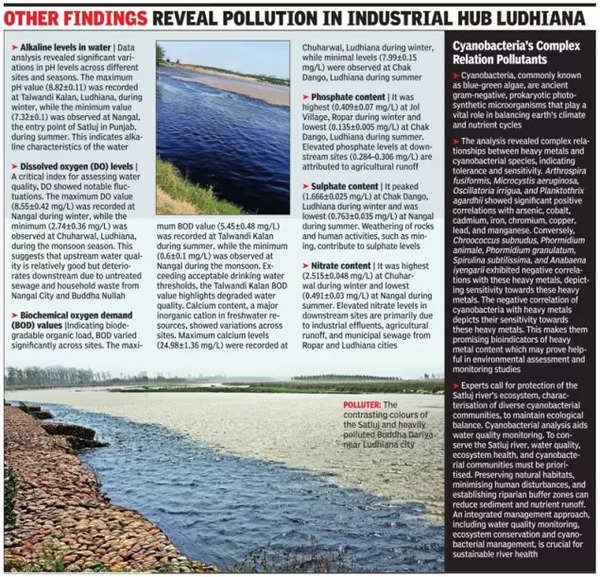
A study by Punjab-based environmental researchers has revealed alarming levels of pollution in the Satluj, posing a significant threat to the region. Water quality and aquatic. The survey revealed stark contrasts in water chemistry between upstream and downstream sites, painting a worrying picture of river health.
While upstream areas remain relatively unpolluted, downstream sites face moderate to severe pollution. The most troubling finding is over-attendance heavy metals at downstream sites, which exceed critical thresholds and endanger the river ecosystem, which emphasizes the urgent need for action to reduce pollution and protect the water quality of the Satluj.
River pollution has reached critical levels in recent decades, with harmful chemicals, heavy metals, excess nutrients and household waste contaminating waterways at an alarming rate. The Satluj in Punjab is particularly vulnerable and suffers from pollution from domestic and industrial effluents and agricultural runoff.
A comprehensive study was conducted to analyze the physicochemical parameters along the river course in Punjab in different seasons. This research focused on identifying seasonal distribution patterns of cyanobacteria, their relationships with water chemistry changes, and informing ongoing monitoring efforts to ensure water quality.

The Satluj originates in Himachal Pradesh and flows into Punjab near the city of Nangal, passing through Ropar, Ludhiana, Jalandhar and Kapurthala districts before converging with the Beas at Harike and entering Pakistan. For this study, the focus was on a part of the river in Punjab. A comprehensive survey of the Satluj in Punjab identified eight strategic sampling sites: Nangal, Jol village, Midani village, Katli, Ropar, Saidpur, Chak Dangu, Choharwal and Talundi Kalan.
Findings of the study “Spatial-temporal distribution of cyanobacteria in relation to water chemistry of Satluj River, Punjab (India)” conducted by Gudershan Singh Rengra, Yadvinder Singh, Komal Thapa and Jasvir Inder Singh Khattar and Davinder Pal Singh. Published in the international journal “Environmental Monitoring and Assessment”.
particle for direct object River pollution index (RPI) from different sampling locations along the river showed significant changes in water quality. Sites with the least human impact, such as Nangal, have an RPI of 1.5, indicating unpolluted conditions. Conversely, areas such as Jol village exhibited moderate pollution, with RPI values ranging from 3.3 in summer and winter to 4 during monsoons, mainly due to sewage waste from Nangal City and National Fertilizer Company Limited. Mid village and Katli, Ropar, recorded RPI values of 2.3 and 2.8 respectively, classifying them as negligible pollution. Saeedpur, Ropar, with an RPI of 3.3, faced pollution from agricultural runoff and sewage from Ropar city. In contrast, Choharwal, Ludhiana and Talundi Kalan showed an alarming rise in RPI indicating heavy pollution. It is noteworthy that Choharwal is the confluence of Budha Nallah and Satluj River, while Talundi Kalan lies downstream. The significant increase in pollution in these places emphasizes the significant contribution of Buddha Nallah to the pollutant levels.
This study showed the alarming trend of increasing the concentration of heavy metals along the Satluj River. Upstream sites (1-4) showed lower levels of heavy metals, while downstream sites (5-8) showed significantly higher concentrations. This indicates the cumulative addition of heavy metals and other pollutants as the river flows downstream from Site 1 to Site 8. Arsenic levels ranged from a low of 0.1±1.2 µg L¹ at Site 1 during summer to an alarming high of 41.8±2.1 µg/L. ¹ at site 8 during winter. Similar patterns were observed for other heavy metals including cobalt, chromium, cadmium, lead, copper, nickel, iron, manganese, and zinc, emphasizing the increasing threat of pollution downstream.
The Heavy Metal Pollution Index (HPI), a key measure for assessing aquatic heavy metal pollution, showed alarming spatial and temporal variations across the Satluj River. HPI values ranged from 53.02 (site 2, summer) to 2820.18 (site 8, winter), exceeding critical thresholds at downstream sites. Upstream sites (1-4) showed relatively low pollution, with HPI values below 100 (53.02-147.04) in all seasons, indicating reduced heavy metal pollution and better water quality. This indicates minimal human impact and effective natural filtration in these areas. Downstream sites exceeded critical HPI thresholds (103.08-2820.18) in all three seasons, indicating severe heavy metal contamination.
#Heavy #metals #contaminate #Satluj #endangering #ecosystem #study #shows #Times #India